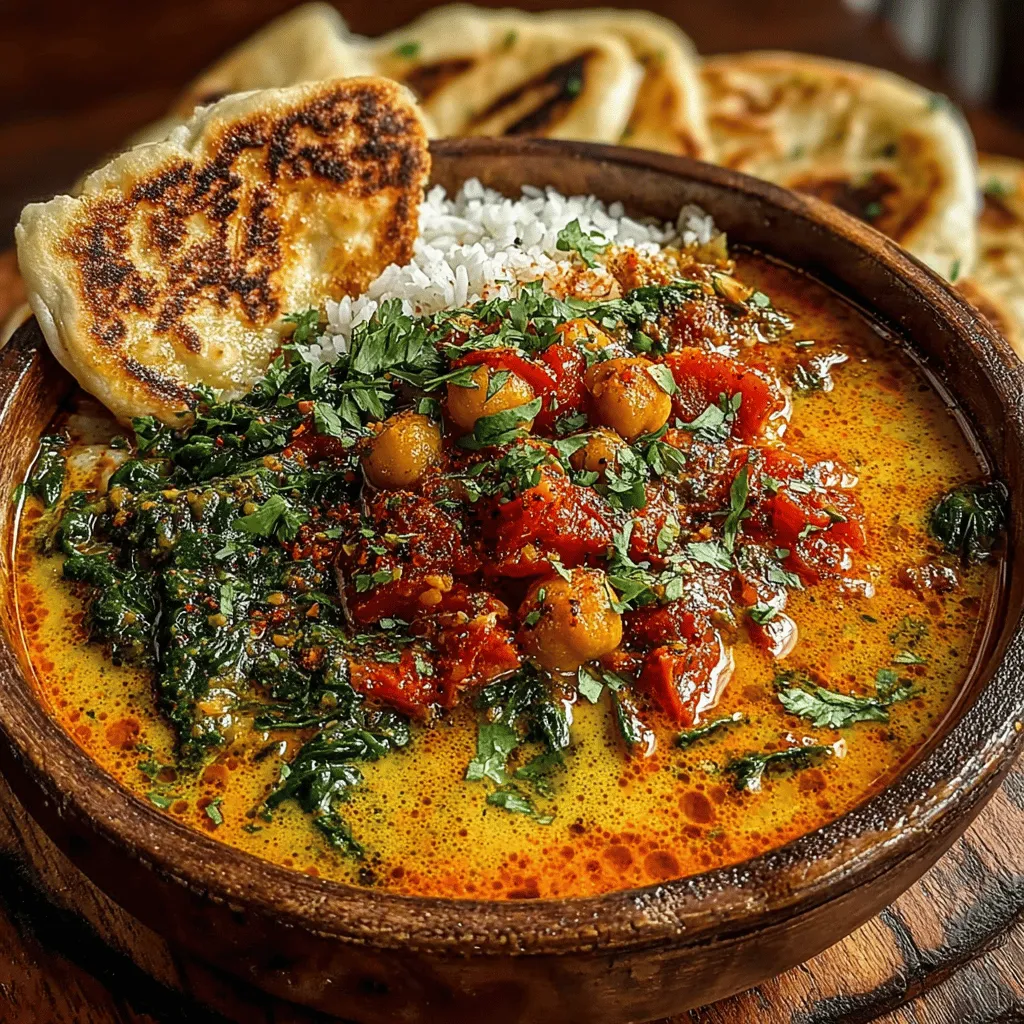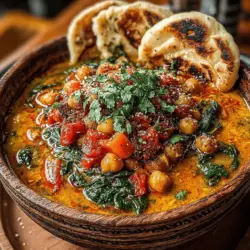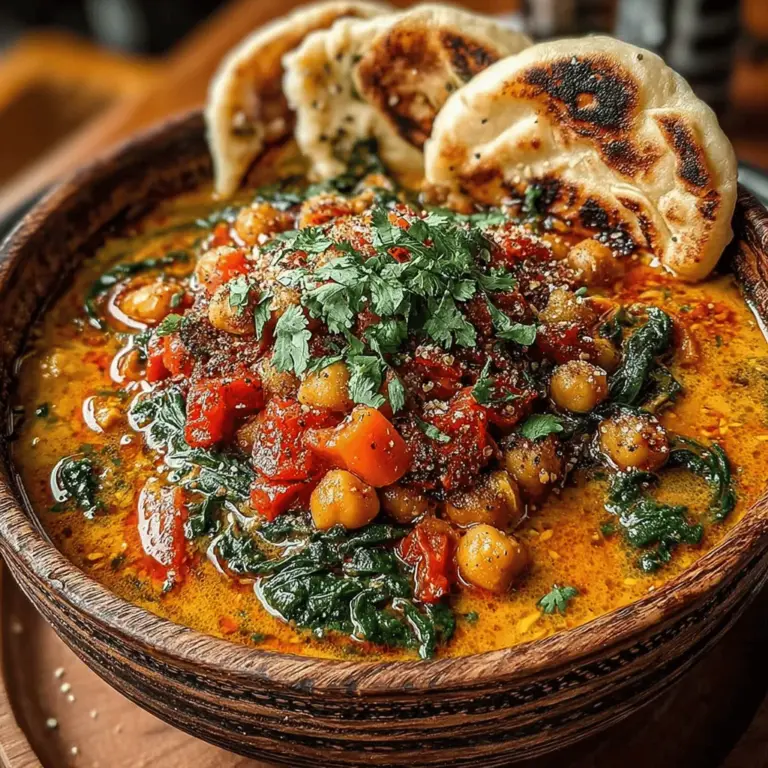Introduction
Coconut chickpea curry is a delightful dish that brings together the rich, creamy flavor of coconut milk with the hearty goodness of chickpeas. This slow-cooked creamy coconut chickpea curry is not only easy to prepare but is also a nourishing option for vegetarians and vegans alike. It’s packed with protein and fiber, making it a satisfying meal for any occasion. In this article, we will guide you through the process of crafting this flavorful dish, from the ingredients needed to the step-by-step cooking instructions, and explore the health benefits and cultural significance of the ingredients used.
Ingredients
– 1 can (15 oz) chickpeas, drained and rinsed
– 1 can (14 oz) coconut milk
– 1 medium onion, finely chopped
– 3 cloves garlic, minced
– 1-inch piece of fresh ginger, grated
– 1 red bell pepper, chopped
– 2 cups fresh spinach, washed and roughly chopped
– 2 tablespoons curry powder
– 1 teaspoon ground cumin
– 1 teaspoon ground turmeric
– 1 teaspoon ground coriander
– Salt and pepper to taste
– 2 tablespoons olive oil
– 1 cup vegetable broth
– Fresh cilantro for garnish (optional)
Instructions
1. Heat the olive oil in a skillet over medium heat. Add the chopped onion and sauté for about 5 minutes until translucent.
2. Stir in the minced garlic and grated ginger, cooking for an additional 2 minutes until fragrant.
3. In a large crockpot, combine the sautéed onion, garlic, and ginger mixture with the drained chickpeas, chopped red bell pepper, and fresh spinach.
4. Pour in the coconut milk and vegetable broth, mixing well to combine all the ingredients.
5. Sprinkle the curry powder, cumin, turmeric, coriander, salt, and pepper over the mixture. Stir until evenly distributed.
6. Cover the crockpot and set it to low heat. Cook for 6-8 hours, allowing the flavors to meld and deepen.
7. Once cooked, give the curry a good stir and taste for seasoning adjustments. Serve hot, garnished with fresh cilantro if desired.
Understanding the Key Ingredients
The Role of Chickpeas in the Curry
Chickpeas, also known as garbanzo beans, are a cornerstone of this dish. They are not only high in protein and fiber, which contribute to a balanced diet, but they also add a hearty texture that complements the creamy coconut milk. Their versatility allows them to absorb the flavors of the spices and sauce, making them a perfect ingredient in this curry.
The Creamy Base: Coconut Milk
Coconut milk serves as the rich and creamy base for this curry, enhancing its flavor and texture. Besides providing a smooth consistency, coconut milk is packed with medium-chain triglycerides (MCTs), which are known for their potential health benefits, including improved energy levels and metabolism. This ingredient not only enriches the dish but also makes it a comforting option for any meal.
Spices that Make a Difference
The spices used in this recipe—curry powder, cumin, turmeric, and coriander—are essential for developing the dish’s unique flavor profile. Each spice brings its own health benefits: for instance, turmeric contains curcumin, known for its anti-inflammatory properties, while cumin is rich in antioxidants. Together, they create a warm and aromatic base that elevates the curry.
Fresh Ingredients for Flavor
Incorporating fresh garlic, ginger, and onion into the curry is crucial for building depth of flavor. These aromatic ingredients not only enhance the taste but also offer numerous health benefits, including immune support and digestive health. The addition of red bell pepper contributes sweetness and vibrant color, while fresh spinach adds a nutritional boost and a touch of earthiness to the dish.
Preparation and Cooking Instructions
Preparing the Aromatic Base
The initial step in preparing your coconut chickpea curry involves sautéing the onions, garlic, and ginger. Begin by heating olive oil in a skillet over medium heat. Add the onions and cook until they become translucent, about 5 minutes. This process is vital for developing a rich flavor base. Next, add the minced garlic and grated ginger, cooking for an additional 2 minutes until they release their fragrant aromas.
Combining Ingredients in the Crockpot
Once your aromatic base is ready, it’s time to combine all the ingredients in the crockpot. Start by adding the sautéed mixture to the pot along with the chickpeas, chopped red bell pepper, and spinach. Pour in the coconut milk and vegetable broth, ensuring everything is well-mixed. Layering the ingredients properly is key to achieving optimal flavor throughout the dish.
Slow Cooking for Flavor Development
Cover the crockpot and set it to low heat, allowing the curry to cook for 6-8 hours. Slow cooking not only melds the flavors together but also allows the chickpeas to soften and absorb the spices fully. This method ensures a rich and satisfying dish that will leave your taste buds craving more.

Cooking Times: Low vs. High Settings
When using a slow cooker, understanding the cooking times for low and high settings is crucial for achieving the best results. Cooking on the low setting typically takes about 6 to 8 hours, while the high setting can reduce this time to approximately 3 to 4 hours. If you’re in a hurry, the high setting is a great option; however, cooking on low allows the flavors to develop more thoroughly, resulting in a richer and more complex taste.
The Importance of Slow Cooking in Building Flavors
Slow cooking is not just about convenience; it plays a vital role in building layers of flavor. The prolonged cooking time allows spices to meld together, creating a harmonious blend that enhances the overall taste of your curry. Additionally, the slow cooking process helps to tenderize the chickpeas and infuse them with the creamy coconut sauce, ensuring each bite is filled with delicious flavor.
Adding Fresh Greens for Nutrition
Incorporating fresh greens into your coconut chickpea curry not only boosts its nutritional profile but also adds a vibrant color and texture.
When and How to Add Spinach to the Curry
For the best results, add fresh spinach during the last 15 to 20 minutes of cooking. This timing ensures that the leaves wilt perfectly without losing their vibrant green color or nutritional benefits. Simply stir the spinach into the curry and cover until it’s tender and fully incorporated.
Adjustments for Using Fresh vs. Frozen Spinach
If you opt for frozen spinach, there are a few adjustments to keep in mind. Frozen spinach should be added about 30 minutes before the curry is done to allow for proper reheating. Make sure to thaw and drain it before adding to avoid excess moisture, which can dilute the flavor of your dish.
Finishing Touches for a Perfect Dish
The final touches can elevate your coconut chickpea curry from good to outstanding.
The Effect of Lime Juice on the Overall Flavor
A splash of fresh lime juice right before serving adds a zesty brightness that balances the richness of the coconut milk. It enhances the overall flavor profile and can make a significant difference in how fresh and vibrant the dish tastes.
Importance of Tasting and Adjusting Seasoning Before Serving
Always taste your curry before serving. Depending on your palate and the ingredients used, you may want to adjust the seasoning with salt, pepper, or additional spices. This step ensures that the flavors are perfectly balanced and aligned with your preferences.
Serving Suggestions
Pairing your coconut chickpea curry with complementary side dishes can enhance the meal experience.
Ideal Pairings with Coconut Chickpea Curry
Steamed rice is a classic accompaniment, as it soaks up the delicious sauce. Alternatively, serve with warm naan bread for a delightful way to enjoy the curry. Consider offering a side of cooling cucumber raita or a fresh salad to balance the warmth of the dish.
Creative Serving Ideas: Bowls, Plates, and Garnishing with Cilantro
For a visually appealing presentation, consider serving the curry in deep bowls, garnished with fresh cilantro. This not only adds a pop of color but also a fresh herbaceous note that complements the curry beautifully. You can also sprinkle some toasted coconut flakes on top for an extra layer of flavor and texture.
Cultural Context of the Dish
Chickpea curry has deep roots in various cuisines, from Indian to Middle Eastern, where legumes are a staple food. This dish showcases the versatility of chickpeas, which are celebrated for their nutritional value and ability to absorb flavors.
How This Dish Fits into a Vegetarian or Vegan Lifestyle
The slow-cooked creamy coconut chickpea curry is an excellent representation of vegetarian and vegan cuisine. Packed with protein from chickpeas and healthy fats from coconut milk, it offers a satisfying meal option for those following plant-based diets.
Health Benefits of Coconut Chickpea Curry
Nutritional Breakdown
This dish is not only delicious but also nutritious. A serving typically contains a moderate number of calories, making it a wholesome choice for any meal. The macronutrient profile is well-balanced, with healthy carbohydrates from chickpeas and fiber that promotes digestive health.
Benefits of the Primary Ingredients for Health
Coconut milk provides healthy fats that are beneficial for heart health, while chickpeas are rich in protein and fiber, supporting muscle health and promoting satiety. Together, these ingredients contribute to a well-rounded meal that nourishes the body.
Vegan and Vegetarian Aspects
As a plant-based dish, it is entirely suitable for vegans and vegetarians. The inclusion of legumes like chickpeas is particularly beneficial as they are high in protein and various essential vitamins and minerals, making them a perfect addition to any diet.
Conclusion
In summary, the slow-cooked creamy coconut chickpea curry is a delicious and nutritious dish that is simple to prepare and full of flavor. With its combination of wholesome ingredients and spices, it not only satisfies the taste buds but also offers numerous health benefits. Whether enjoyed on a cozy night in or served at a gathering with friends and family, this curry is sure to impress and nourish. Its ease of preparation and rich flavor profile make it an essential recipe for anyone looking to incorporate more plant-based meals into their cooking repertoire.

